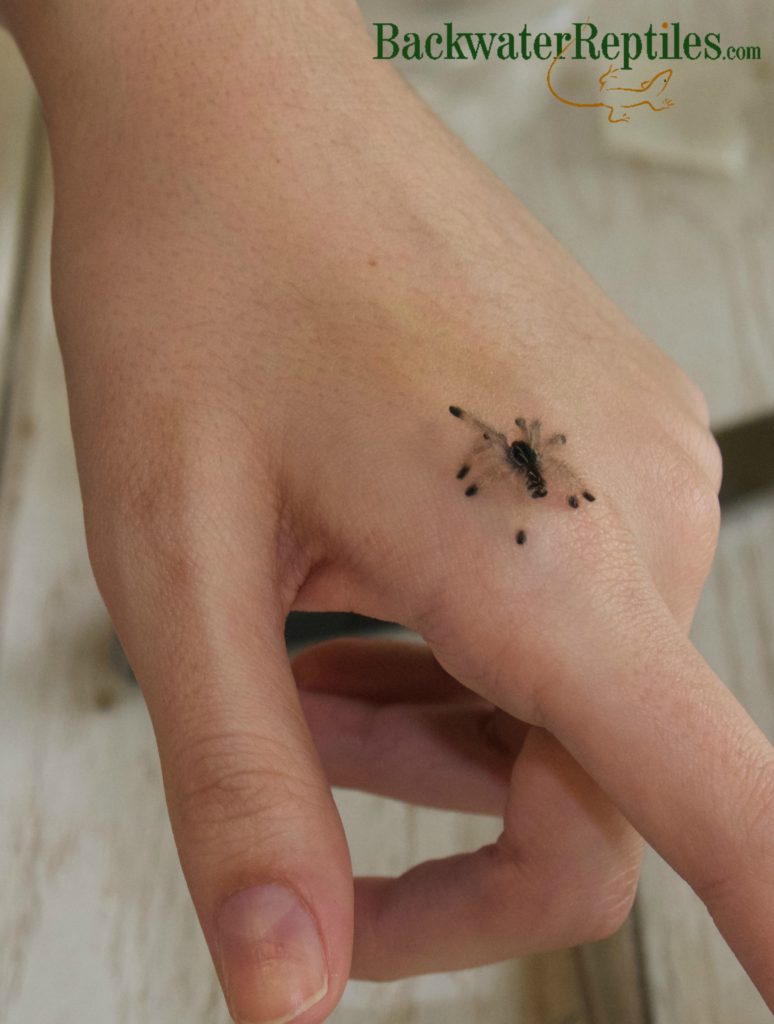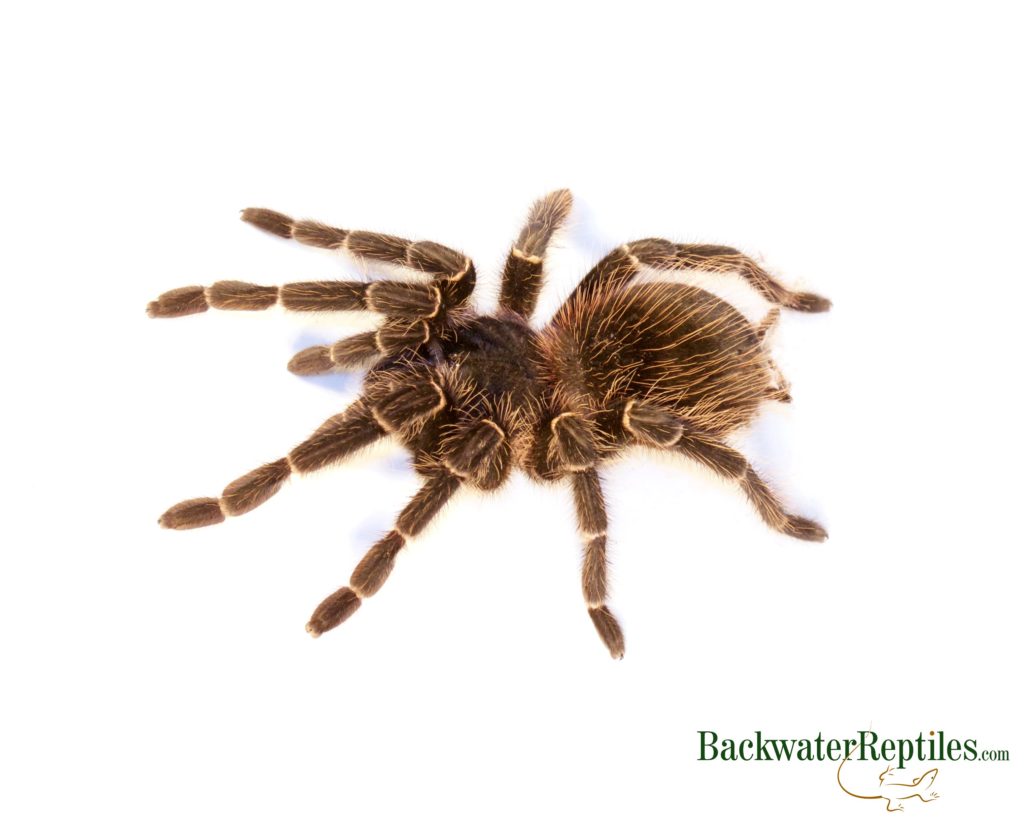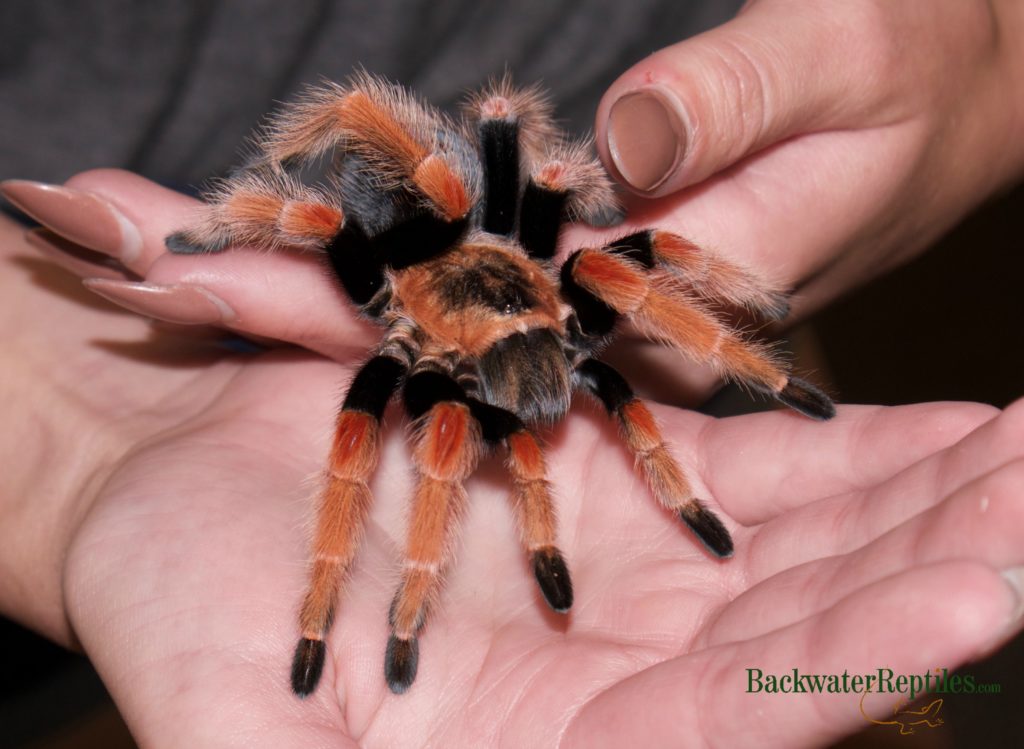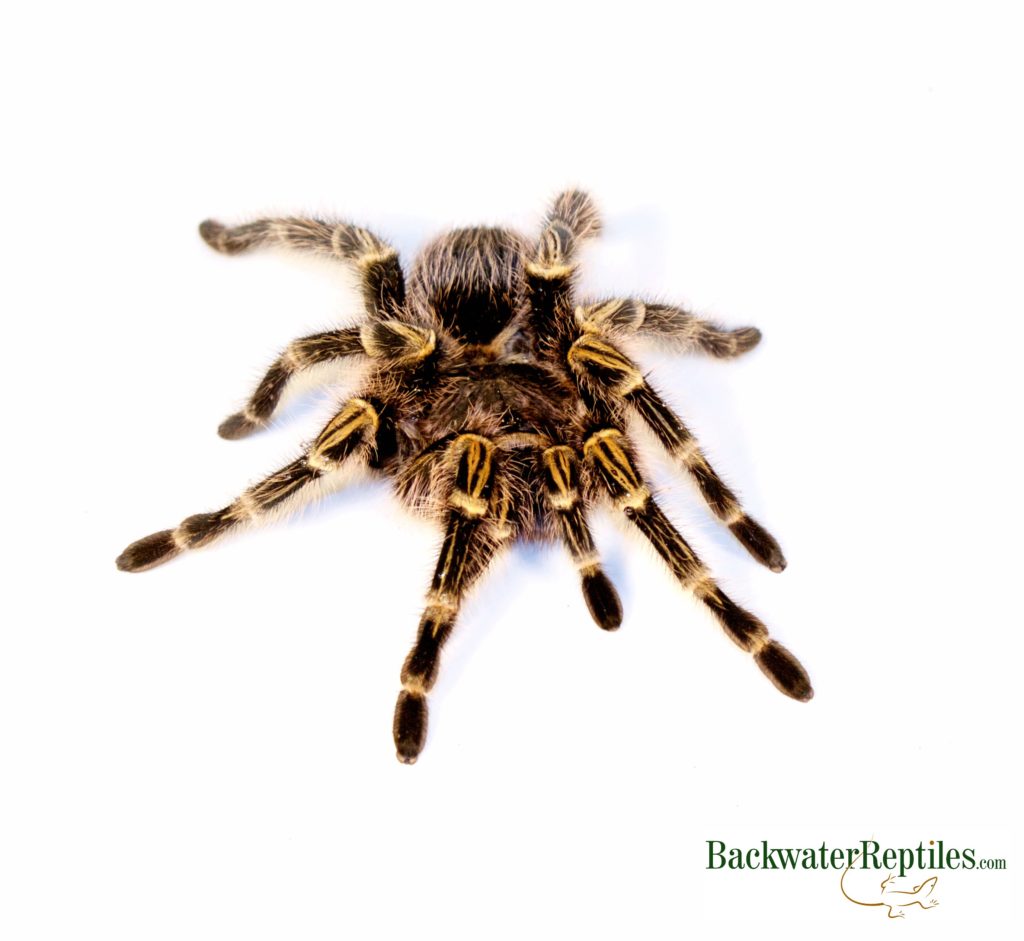Although tarantulas are not the most hands-on type of pet, they can be handled and interacted with if you understand the animal and its body language.
While we recommend leaving your pet tarantula to its own devices most of the time, there will be times when you will need to remove your spider from its enclosure. The most common time to take your spider out of its cage is when it requires cleaning.
In this article, we will discuss tips, tricks, and methods for removing your spider from its enclosure as well as handling it in a manner that is the most stress-free for both you and your arachnid.

How To Pick Up Your Pet Tarantula
Why would I need to pick up my pet tarantula?
Although it is true that in general most species of tarantula are best observed and not handled, if you are a tarantula owner, odds are that at some point in your spider’s life, you will have to remove the arachnid from it enclosure.
The most common reason to pick up any pet tarantula is to clean the spider’s cage. However, if you are a diligent spot-cleaner, you can certainly keep full-enclosure cleanings to a minimum. For instance, you should make sure to remove any molt exoskeletons once your spider has fully completed the process. Any uneaten cricket or insect corpses should also be removed in a timely fashion.
Many tarantula owners also have the desire to interact with their spider on a one on one level. Again, this should be done by experienced arachnid owners who know how to read their spider’s body language.
While tarantulas might not appear fragile, they can be rather delicate. Plus they have what are called urticating hairs that can be shed in distress. These hairs not only irritate human skin, but they can leave bald marks on the spider if they become overstressed and shed too many of these hairs.

How do I handle my pet tarantula?
So now that you know that pet spiders can in fact be picked up and held if you choose to do so, what is the proper way to go about doing so? How do you pick up the spider without stressing it or causing it to bite?
First of all, you’ll want to know that there are certain species of tarantula that we simply do not recommend holding with bare hands, regardless of your experience level. You can read more about those particular species later on in this article.
But if you do have a species of tarantula that is suitable for limited human interaction, first and foremost, before you even place your hand anywhere near the spider, you’ll want to know how to read the arachnid’s body language. Most tarantulas have very clear indicators that they are not in a good mood and if you notice any of these behaviors, you’ll want to steer clear of handling the spider until the bad mood has passed.
Here are the most common signs that your spider is simply not interested in interacting with you:
- Your tarantula lifts a leg or two from the ground and waves it. While the remainder of your spider’s body will stay grounded and relaxed, one or two of its front legs will raise up and be tense.
- Your tarantula is rearing up and displaying its fangs. This behavior is a very clear indicator that your spider is feeling aggressive. Odds are if you attempt to pick up, hold, or otherwise disturb your spider while it is in this posture, it will either attempt to bite you or rub urticating hairs in your direction.
- Your spider turns around and faces its abdomen towards you. This stance is usually followed by the tarantula rubbing its legs against its abdomen. If your arachnid does this, it is flicking urticating hairs in your direction and you should steer clear if you don’t want your skin to be irritated, red, and itchy.
- Your tarantula is extremely sluggish, slow, and hasn’t eaten in a while. In most cases, this means your spider is preparing to molt. While your tarantula might not be exceptionally grumpy during this time, you’ll certainly want to avoid disturbing it or handling it because it can upset the molting process and be hazardous to your spider’s health and well-being.
- If your tarantula is lying on it back upside down. This is a sure sign that the spider is undergoing the molting process and definitely should not be disturbed or moved in any way.

If your tarantula is flat with his legs bent and abdomen gently parallel to the ground, it means that it is relaxed and feels safe in its current state. This type of posture means that your spider is in the proper mood to be held.
Once you’ve determined that your spider’s body language indicates you can interact with it, the next step is to make sure you are wearing the proper clothing. You might want to wear pants, long sleeves, and sometimes even gloves depending on the personality of your spider. Less skin that you have exposed means there is less of an opportunity for the tarantula to bite you should it become startled or defensive.
If you want to be hands on with your spider, we do recommend wearing gloves until you are 100 percent at ease with your pet and know how it tends to react and behave in general.
If you can, it’s best to have the spider on a flat surface so that you can gently place one hand in front of it and the other behind it to softly encourage the spider forward onto your hands.
Once you have eased the spider into your hands, make slow movements, speak softly, and avoid poking, prodding, or waving the spider around. Being at ease around your tarantula will in return put the animal itself at ease.
You can also use the “paper sliding under a cup” method of picking up your spider. More on that method later. Helpful hint: this method is best for very aggressive spiders.

What tips and tricks do you know for interacting with my tarantula?
A really good piece of advice that is (hopefully) self-evident for most spider owners is to keep your fingers away from the spider’s fangs. Don’t poke it or try to hand feed it. If you want to train your spider to accept food from you on command, always use tongs.
Be calm. When you make slow movements you will keep your spider in a calm mindset and it will feel far less threatened than if you make quick, frantic, or jerky movements.
Avoid touching the tarantula’s abdomen. Spiders that possess urticating hairs have them on their abdomen and if you brush these or rub them too hard, they will be released into your skin, which is not a pleasant experience for the spider or for the owner.
When you handle or interact with your tarantula, make sure that you are well out of the reach of other household pets. Avoid handling your spider around noisy dogs, clingy cats, or even other pet spiders. It’s best for the safety of all parties, human and animal, that are living in the household.
If you have a particularly active spider, hold it over a flat surface so that if it unintentionally walks out of your hand, it will not be injured by a fall from a high place. We also recommend keeping overactive spiders in your hands – don’t let them crawl into your hair, clothing, or appendages.
Which species of tarantula are the most interactive?
While many species of tarantula that are not considered classically docile can be held, it is true that there are certain types that are known for their calm temperaments and ability to interact with their owners.
A few species that are excellent spiders for beginners and for people who want to hold their spider are: Mexican Red Knees (Brachypelma smithi), Brazilian Blacks (Grammostola pulchra), Rose Hairs (Grammostola rosea), Curlyhairs (Brachypelma albopilosum), and Pink Toes (Avicularia avicularia).
Which species of spider should not be handled?
Certain species of tarantula are known for their aggressive natures and propensity to fling urticating hairs and/or bite. These types of spiders should not be held. If you need to remove the spider from its enclosure, we recommend wearing gloves or using the paper sliding underneath a cup method.
Here are a few species of spider sold by Backwater Reptiles that we do not recommend picking up: any species of “Baboon” tarantula (King Baboons, Orange Baboons, Ornamental Baboons, etc), Goliath Bird Eaters, and Trapdoor Spiders. Each of these species would pack quite a painful bite.
What should I do if my spider is aggressive?
If you cannot get your pet spider to voluntarily walk into your hands, then you might want to try using a stiff piece of paper and a cup, bowl, or another similar object to place on top of the spider. Then you can gently scoot the stiff paper underneath the cup and pick up the entire set up and move the spider where you need it to go.
This method is best used for spiders that are not meant to be held or for spiders with tricky dispositions. It’s also great for arachnids that are easily stressed.
If you do accidentally get bitten by your spider, the first thing you should do is not panic. You’ll likely be very distracted and possibly even frightened of your spider if you get bitten, but in order to avoid further injury to either you or your pet spider, you’ll need to gently remove the spider from your person and place it back into its enclosure.

The next step to take in the event of a tarantula bite is to clean the wound. Wash it with soap and water and apply an antiseptic. Watch for signs of infection, a lot of redness, difficulty breathing or an abnormal amount of swelling. If you notice any of these signs, we highly recommend seeking professional medical attention as you could be having an allergic reaction to the bite.
It’s very likely that your spider bite will be painful and likely get a bit puffy and red. Any normal pain reliever such as acetaminophen or Ibuprofen should help with the discomfort.
Should you be unlucky enough to get urticating hairs in your skin, the best way to remove them is to use a piece of tape. Put the sticky side on the affected area and pull it off and the hairs should come out.
If you experience a lot of itching, swelling, or other discomfort after handling a tarantula or after knowingly having urticating hairs flicked onto you, it might be necessary to see a physician, although most cases are not that serious.
NOTE: You should never put your face and/or eyes close to a tarantula, but if you do somehow get urticating hairs in your eye, we do recommend seeing a doctor as soon as possible if you experience side effects that are adverse or long-lasting.
Conclusion
Tarantulas make excellent pets! They are beautiful to look at, fairly low maintenance, and can be fun to handle.
Please keep in mind when buying a pet spider that not all species are meant to be picked up or held. Some species are more docile than others and will take well to human handling, while others are aggressive in nature and should be “look don’t touch” pets.
If you would like recommendations on the best species of spider to keep for your needs or for your family’s needs, you can always ask in the comments section or email our customer service support team at sales@backwaterreptiles.com.
